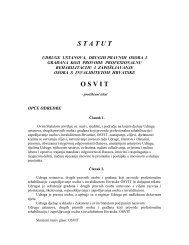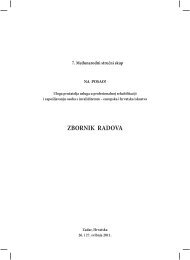zbornik radova - Osvit
zbornik radova - Osvit
zbornik radova - Osvit
You also want an ePaper? Increase the reach of your titles
YUMPU automatically turns print PDFs into web optimized ePapers that Google loves.
HANS VRIND • Developments of (re)integration to work in The NetherlandsThe work ability concepttions. Rooted in the rest of the policy is important becausecalled Star Rating system, operated by the Government.the WAI only a supportive tool, not an end in itself.This benchmark system is based on the net effectivenessWORK ABILITYWORKIn 2005 I met in Washington one of the (then) new membersof Workability Europe: Rolf Salo. He is the owner ofthe biggest privately – owned German rehabilitation orga-of contracting parties. Thus they shall be able to providethe best performing contractors to hire and give additionalincentives to contractors to improve performance in a su-nizations. His lecture (then, in Arlington) made everythingstainable relationship with the client. It gives guidance onfall into place:price-quality space for innovation. (source TNO)• Vocational re-Integration starts on the stretcherIn The Netherlands we are not that far!!“‘Work ability’ is of high relevance for each worker and for hisor her organisation. According to the Finnish researchers Ilmarinen& Tuomi (2004), work ability may be understood asVALUES• early – intervention• keep it purely individual• Join medical, psychosocial, social and occupational ac-Conclusions1. Use Private companies, no institutions‘how good is the worker at present, in the near future, andhow able is he/she to do his/her work with respect to thework demands, health and mental resources’. This definitionis based on a so called ‘concept of work ability’ (Ilmarinen,2004) according to which, work ability is the result of theinteraction of the worker and his or her work. Work abilitymay also be described as the balance of the workers’ resourcesand the work demands.The worker contributes to his work ability via his health andPROFESSIONALCOMPENTENCEHELTHtivities together aiming to re-establish among sick orinjured people with previous work history their workingcapacity and prerequisites for returning to the labormarket• involve the family, their social network and their presentemployer• cess of inter-collegiality (avoid the medical dominance!!• do not institutionalize!2. Vocational re-Integration starts on the stretcher3. Create a situation of Early intervention. Find a job (oldemployer??), to set a goal!4. Use Multi disciplinary Teams (on equal basis, no medicalemperors)5. Use no groups to offer skills for rehabilitation. Focuson the individual, but remind every person is time –consuming. Take your time!functional abilities, with knowledge, skills, attitudes andmotivation. The workplace influences the work ability throughwork organizational factors - especially leadership andmanagement issues - by work demands and by the workenvironment, including social factors.Given the increasing necessity of older people’s participationin the labour market, the decreasing possibilities for prematuredeparture from working life and also the weakeningof the social networks, work ability becomes a more andmore relevant concept in Europe.”Again Hasselhorn: “The translation of the ‘concept of workability’ into an organisation may be illustrated by the ‘houseof work ability’ (Ilmarinen 2004). This visualizes that theworkers’ health (1st floor) is a foundation for work ability.The 1st (ground) floor can bear the work demands only whenenough professional and social competence is available.The relevance of the 2nd floor is increasing in current timesral values of the worker. Here, respect, esteem and justiceplay a role as much as commitment to the organisation,motivation and engagement. These values influence the abilityand motivation for learning and qualification (2nd floor).The 4 th floor, finally, summarises all aspects of the workcontent (physical, psychological and social demands), thework environment and work organisation. Here, leadershiphas a core influential role, but also work factors such aspossibilities for development and influence at work. Close byare the worker’s family, private social life and society, whichalso have an impact on work ability.”Ilmarinen created a so called Work Ability IndexThis offers employees and employers the opportunity tosomeone’s long-term employability accurate mapping. Onthat basis, they can take timely action to avoid disruptionsand reduce or prevent disability.• put the job-coach on the focal point• find the relevant financiers!• steer on results!And results are there, so about 2 of 3 clients do reach(again) a professional status in the job they wish and inwhich they are happy. Compared to The Netherlands, thedifference is shocking!That brings me to my last point. Measuring on results. Statisticsare lies! Everybody in our industry knows the term:“picking low hanging fruit”, what means: get paid for successfulrehabilitation while the real progression to a job wasmade by the disabled person himself single handed. (Forinstance because he or she was sick of the bureaucracyand/or the coach). So: how do we, re-habilitators measureour success:??The Australians have a good option:6. That cost a lot of money, but you have a good argument:The saving of the future allowances is at stake!7. Use The ‘house of work ability’ criteria (Ilmarinen 2004)8. Be aware of the Family, they are not only cooperative9. Use the abilities of every person10. Target: Be successful at least with 2 out of 3With every single person, who can use his full abilities in ajob, you win the world!Rijswijk, 5 th of May 2010, Hans VrindFor reference and readings, see Hans Martin Hasselhorn,University of Wuppertal, Germany:• Ahonen G, Bjurström LM, Hussi T. Economic Effectivenessof the Maintenance and Promotion of Work Ability.In: Peltomäki P, Hussi T, Julin H, Launis K, Liira J, RäsänenK. Maintenance of Work Ability – Research and Assess-when continuous change is becoming a main characteristicWAI deserves – according to Hasselhorn - a permanentIn Australia the effectiveness of private providers of reha-ment: Summaries. Ministry of Social Affaires and Health,of working life. The 3rd floor represents the social and mo-place in the health, working conditions and staffing organiza-bilitation services improved after the introduction of a so-Finnish Institute of Occupational Health. 2002, 33-44.88 Z B O R N I K R A D O V A 6 . M E Đ U N A R O D N O G S T R U Č N O G S K U P AProfesionalna rehabilitacija osoba s invaliditetom – vrata za ponovni ulazak u svijet rada 89








